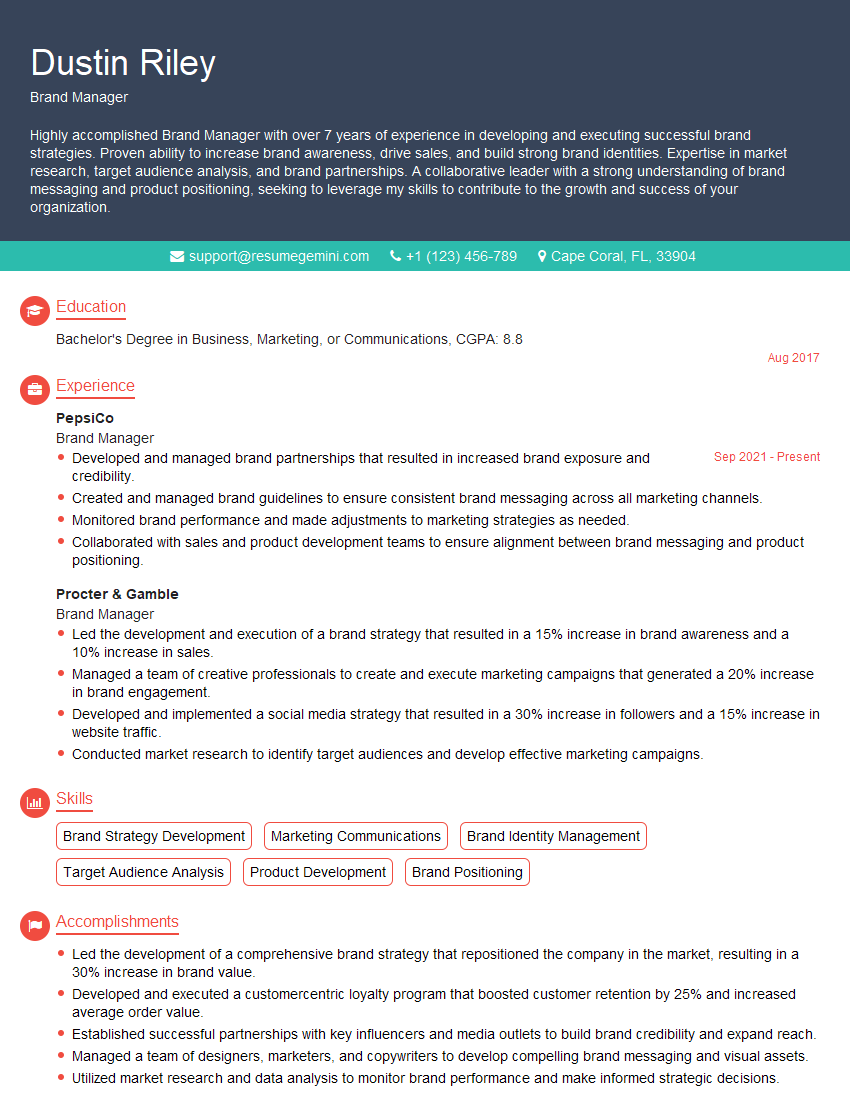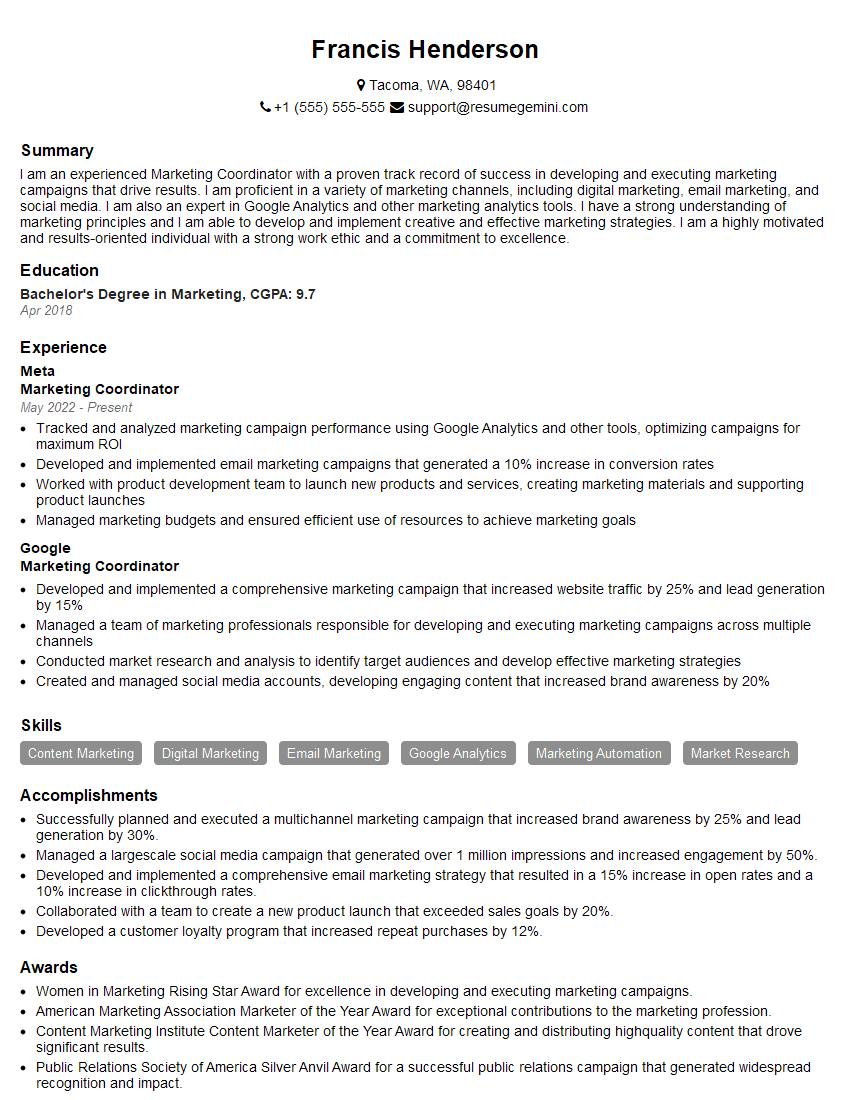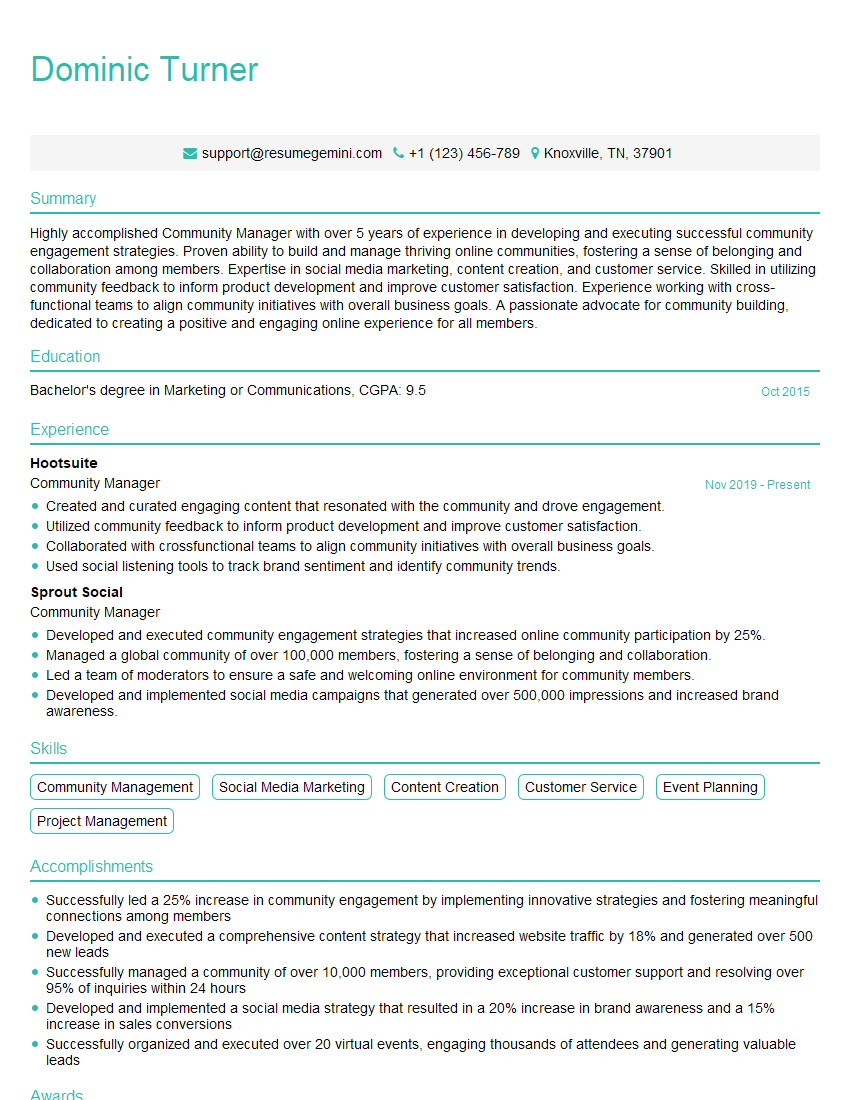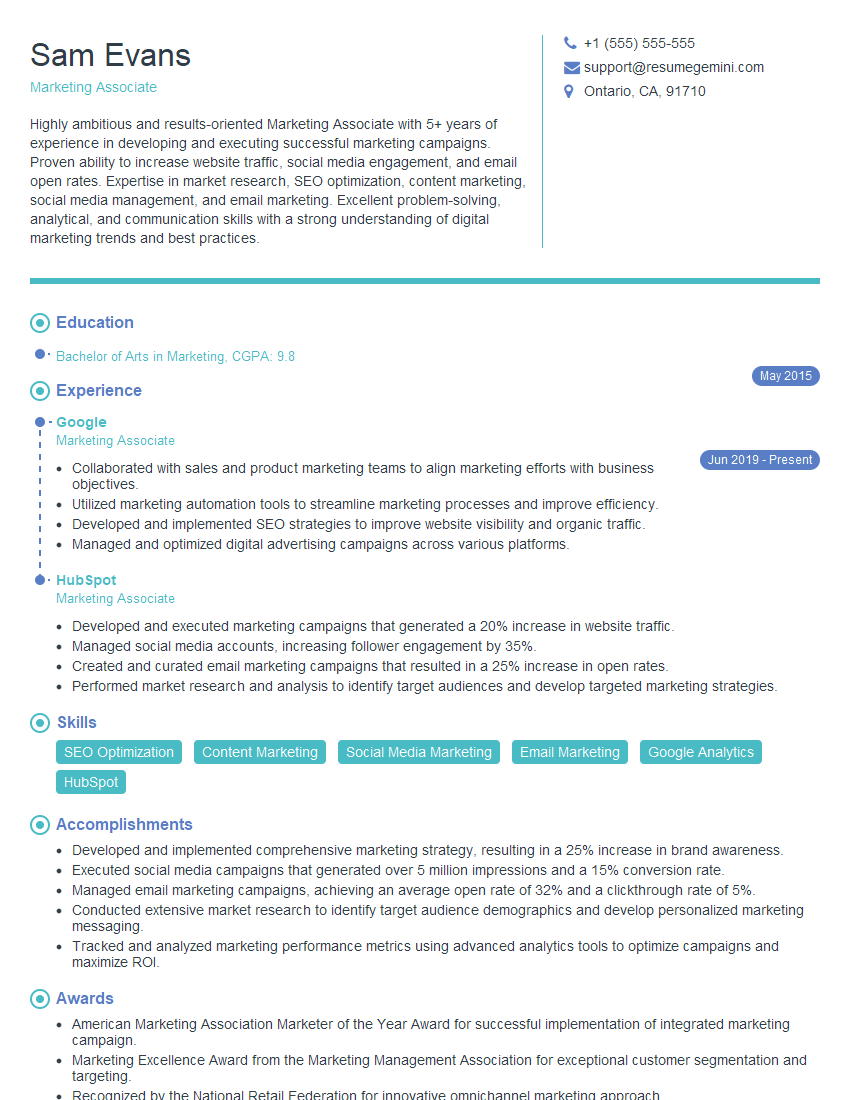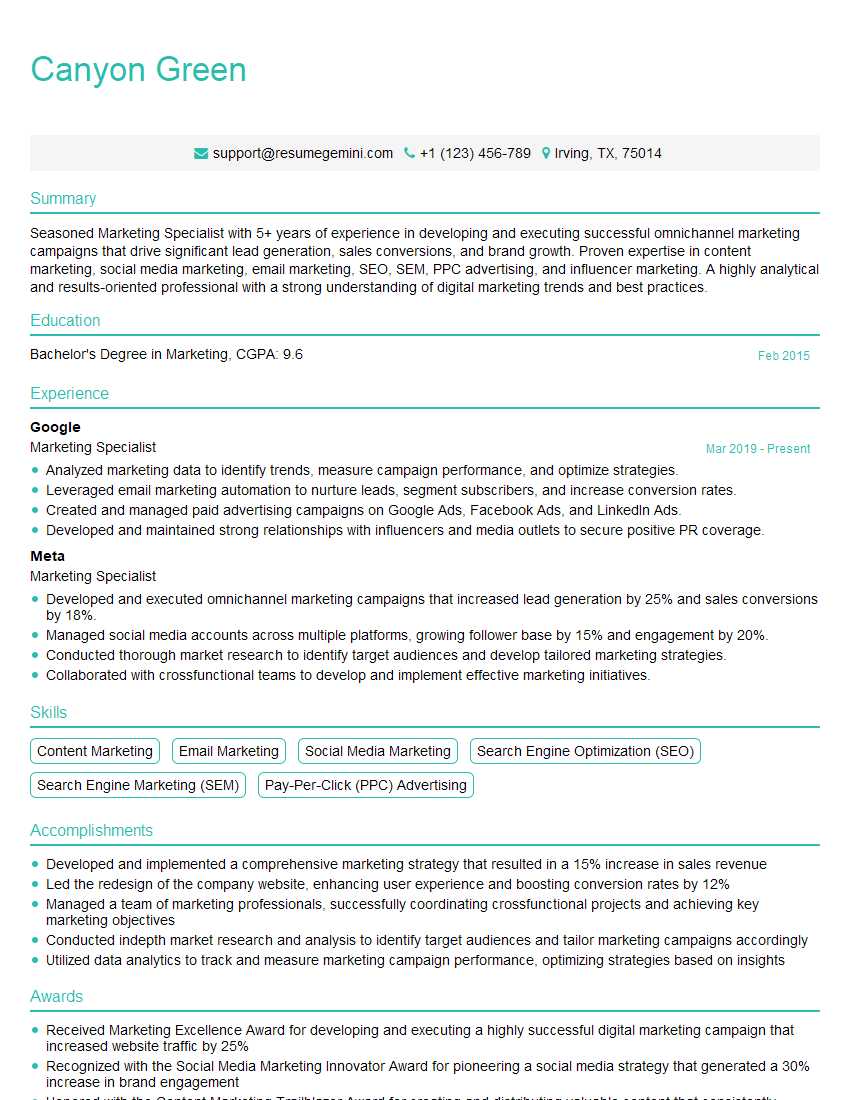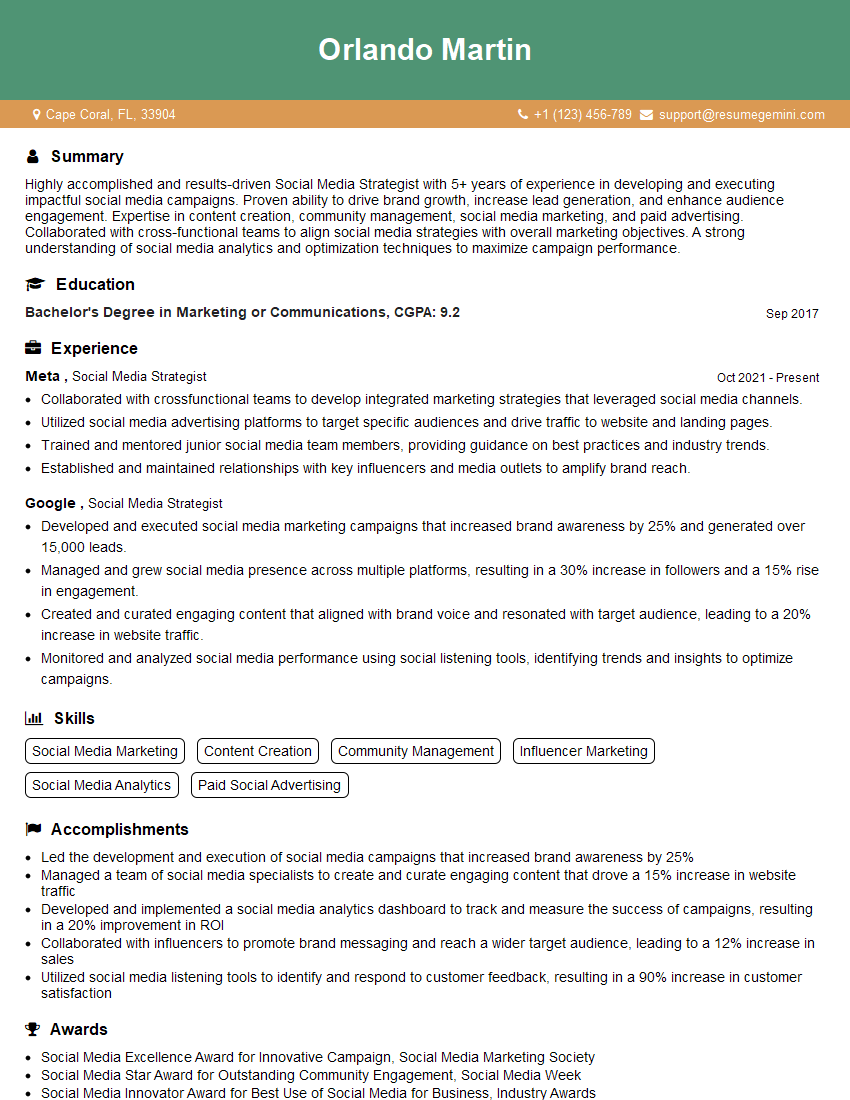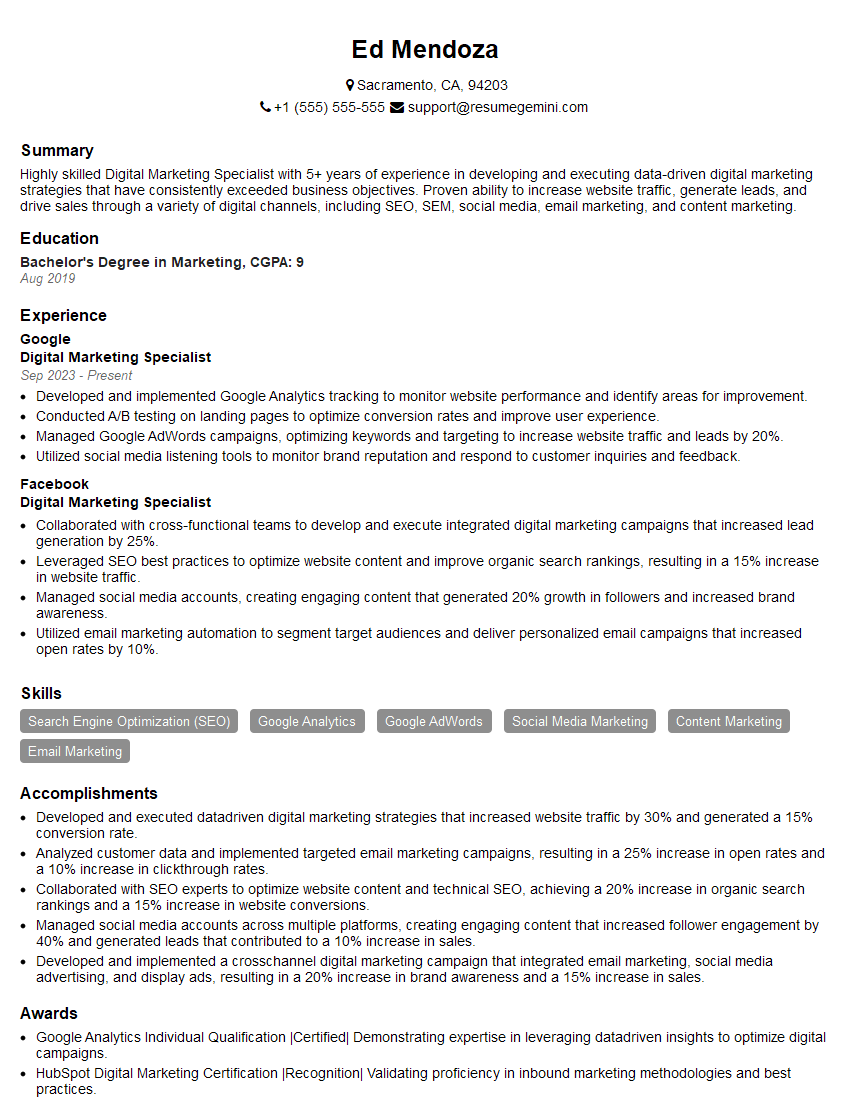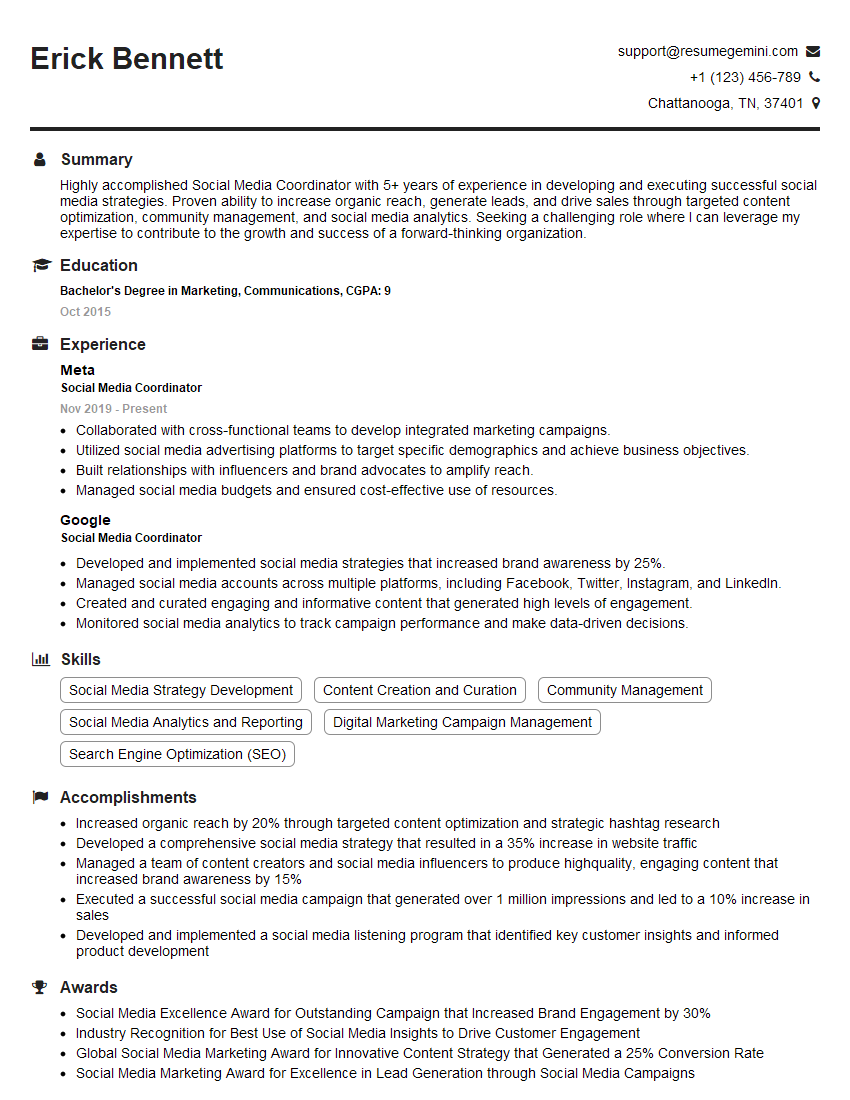Cracking a skill-specific interview, like one for Marketing and Social Media, requires understanding the nuances of the role. In this blog, we present the questions you’re most likely to encounter, along with insights into how to answer them effectively. Let’s ensure you’re ready to make a strong impression.
Questions Asked in Marketing and Social Media Interview
Q 1. Explain your understanding of the marketing funnel.
The marketing funnel is a visual representation of the customer journey, illustrating the stages a potential customer goes through from initial awareness to becoming a loyal advocate. It’s often depicted as a funnel because each stage filters out those who aren’t progressing towards a purchase or desired action. Think of it like a sieve, where the widest part at the top represents the largest pool of potential customers and the narrowest part at the bottom represents those who have completed the desired action.
- Awareness: The top of the funnel. Potential customers become aware of your brand or product through various channels like social media, advertising, or word-of-mouth.
- Interest: Customers show interest in your offering. They might research your product, read reviews, or engage with your content.
- Decision: Customers evaluate your product against competitors and decide whether it meets their needs.
- Action: Customers take the desired action, such as making a purchase, signing up for a newsletter, or requesting a quote.
- Loyalty: This final stage focuses on retaining customers through excellent customer service, loyalty programs, and ongoing engagement.
For example, a coffee shop might use social media ads to create awareness (Awareness). Engaging content about their ethically sourced beans might spark interest (Interest). A customer might then compare their prices and offerings with competitors (Decision), ultimately buying a cup of coffee (Action). Finally, a loyalty program ensures they return (Loyalty).
Q 2. What is the difference between SEO and SEM?
SEO (Search Engine Optimization) and SEM (Search Engine Marketing) are both strategies for improving your website’s visibility in search engine results, but they differ significantly in their approach.
- SEO focuses on organic (unpaid) search results. It involves optimizing your website’s content, structure, and technical aspects to rank higher in search engine results pages (SERPs) without paying for placement. Think of it as building a strong foundation to naturally attract traffic.
- SEM, on the other hand, involves paid advertising on search engines. SEM uses platforms like Google Ads to create and run paid search campaigns, paying for your website to appear at the top of SERPs or in other prominent ad placements. This is a faster way to reach a wider audience but requires a budget.
In short: SEO is about earning visibility, while SEM is about buying visibility. A successful digital marketing strategy often combines both SEO and SEM for optimal reach and impact.
Q 3. Describe your experience with Google Analytics.
I have extensive experience using Google Analytics to track website traffic, user behavior, and campaign performance. I’m proficient in setting up and configuring tracking codes, creating custom dashboards, and analyzing key metrics to inform data-driven decision-making. For example, I’ve used Google Analytics to:
- Identify top traffic sources: Pinpointing which marketing channels are driving the most valuable traffic (e.g., social media, organic search, email marketing).
- Track conversion rates: Measuring the percentage of website visitors who complete desired actions, such as making a purchase or filling out a contact form. This allows for optimization of the website’s conversion funnel.
- Analyze user behavior: Understanding how users navigate the website, which pages they spend the most time on, and where they drop off. This helps improve website usability and user experience.
- Segment audiences: Grouping users based on specific characteristics to tailor marketing campaigns and personalize messaging. This helps improve campaign effectiveness and ROI.
I am comfortable interpreting complex data sets and presenting key findings to stakeholders to support strategic decision-making within marketing.
Q 4. How do you measure the success of a social media campaign?
Measuring the success of a social media campaign requires a multi-faceted approach, focusing on both quantitative and qualitative data. The specific metrics you track depend on your campaign objectives, but generally include:
- Reach: The total number of unique users who saw your content.
- Engagement: Interactions with your content, such as likes, comments, shares, and retweets. A high engagement rate indicates that your content is resonating with your target audience.
- Website traffic: If driving traffic to your website is a goal, you’ll track clicks from social media posts to your website.
- Conversions: The number of users who complete a desired action after seeing your social media content, such as making a purchase or filling out a form.
- Brand mentions and sentiment: Tracking mentions of your brand on social media to understand public perception and identify potential PR issues.
Beyond numbers, qualitative analysis includes examining the tone and nature of comments to gauge audience response and refine future strategies. For example, a successful campaign might have a high engagement rate, significant website traffic from social media, and overwhelmingly positive brand mentions.
Q 5. What social media platforms are you most proficient in and why?
I’m most proficient in using LinkedIn, Instagram, and Facebook. My proficiency stems from understanding their unique user demographics and the best strategies to reach them.
- LinkedIn: Ideal for B2B marketing and professional networking. I use it for content marketing, lead generation, and building professional relationships. Its emphasis on professional profiles allows me to target a highly specific audience.
- Instagram: Excellent for visual storytelling and reaching a younger demographic. I utilize high-quality images and videos to create engaging content that resonates with this audience, frequently leveraging trending hashtags and engaging in relevant conversations.
- Facebook: A highly versatile platform with diverse audience segments. I’ve experience using Facebook for targeted advertising, community building, and content distribution. Its detailed targeting options allow me to laser-focus campaigns and measure ROI precisely.
My proficiency extends beyond simply posting content; it involves understanding algorithm updates, analytics, and campaign management on each platform.
Q 6. What are your strategies for increasing engagement on social media?
Increasing social media engagement requires a strategic approach combining high-quality content with interactive elements. My strategies include:
- Creating high-quality content: This includes visually appealing images and videos, informative text, and compelling storytelling. I focus on content that is relevant and valuable to my target audience.
- Running contests and giveaways: These can significantly boost engagement and expand reach, generating excitement and encouraging interaction.
- Using interactive content formats: This might involve polls, quizzes, Q&A sessions, and live videos, to encourage active participation from followers.
- Engaging with comments and messages: Prompt and thoughtful responses to comments and messages show that you value your audience and create a sense of community.
- Using relevant hashtags: This expands reach and helps people find your content when searching for relevant topics.
- Collaborating with influencers: Partnering with relevant influencers can help expose your brand to a wider audience.
- Analyzing and adapting: Regularly analyzing engagement metrics allows you to refine your strategy and adapt to changing audience preferences.
For instance, I might launch a photo contest encouraging users to share their experiences with a product using a branded hashtag. This combines high-quality visual content, user-generated content, and a clear call to action, maximizing engagement potential.
Q 7. How do you handle negative comments or reviews on social media?
Handling negative comments or reviews on social media requires a calm, professional, and empathetic approach. My strategy involves:
- Responding promptly: Addressing negative feedback quickly shows that you care and are responsive to your audience’s concerns.
- Acknowledging the user’s feelings: Start by acknowledging their feelings and validating their experience. Phrases like ‘I understand your frustration’ or ‘I’m sorry to hear that’ can go a long way.
- Taking responsibility (if applicable): If your business is at fault, take ownership of the mistake and offer a sincere apology.
- Offering a solution: Propose a solution to resolve the issue, whether it involves a refund, replacement, or simply an explanation.
- Taking the conversation offline: If the issue is complex or requires sensitive information, offer to contact the user privately to resolve the issue.
- Monitoring and preventing future issues: Reviewing negative comments helps identify patterns and address underlying issues to prevent similar problems from arising in the future.
It’s crucial to avoid getting defensive or engaging in arguments. The goal is to address the concern, show empathy, and ultimately turn a negative experience into a positive one, demonstrating your commitment to customer satisfaction and brand reputation management. If many negative comments appear, this indicates an underlying issue needing broader internal attention.
Q 8. Explain your understanding of A/B testing.
A/B testing, also known as split testing, is a controlled experiment where two versions of a webpage, email, or ad are shown to different groups of users to determine which performs better. It’s a cornerstone of data-driven decision-making in marketing.
For example, you might A/B test two different headlines for an email campaign. Version A uses a concise headline, while Version B is more descriptive. By tracking the open rates and click-through rates for each version, you can determine which headline resonates better with your audience and optimize your future campaigns accordingly.
A/B testing is crucial because it moves beyond guesswork. Instead of relying on assumptions about what will work, you collect data to validate your hypotheses and continuously improve your marketing efforts. The key is to only change one variable at a time, ensuring you accurately attribute performance differences to the specific element being tested.
- Hypothesis: Clearly define what you’re testing and what outcome you expect.
- Control Group: Establish a baseline version (A) to compare against.
- Variation Group(s): Create variations (B, C, etc.) that test specific elements.
- Statistical Significance: Ensure enough data is collected to draw meaningful conclusions.
- Analysis: Evaluate the results to determine the winning variation and make informed decisions.
Q 9. What is your experience with content marketing?
Content marketing is all about creating and distributing valuable, relevant, and consistent content to attract and retain a clearly defined audience — and, ultimately, to drive profitable customer action. My experience spans various content formats, including blog posts, infographics, videos, ebooks, and social media updates.
In a previous role, I developed and implemented a content strategy for a SaaS company focused on project management. We identified key customer pain points and created a series of blog posts, case studies, and webinars addressing these concerns. This resulted in a significant increase in organic traffic, lead generation, and ultimately, sales. We also leveraged user-generated content through customer testimonials and reviews, enhancing credibility and social proof.
My approach to content marketing is data-driven. I track key metrics like website traffic, engagement rates, lead generation, and conversion rates to constantly optimize our content strategy. I believe in creating a content calendar and aligning the content with the overall marketing goals. It’s not just about creating content; it’s about creating effective content that achieves specific business objectives.
Q 10. Describe your experience with email marketing.
Email marketing remains a powerful channel for nurturing leads and driving conversions. My experience includes developing email campaigns for various purposes, including lead nurturing, promotional announcements, event invitations, and transactional emails.
I’m proficient in using email marketing platforms such as Mailchimp, Constant Contact, and HubSpot to create engaging email templates, segment audiences, automate email workflows, and track campaign performance. For example, I once implemented a personalized email nurture sequence for a client that significantly improved their lead conversion rate by delivering targeted content based on subscriber behavior and preferences. This involved segmenting the audience based on their engagement with previous emails and website activities, resulting in more relevant and effective communication.
Beyond the technical aspects, I focus on creating compelling email content that adheres to best practices for email deliverability and engagement. This includes optimizing subject lines, using clear calls-to-action, and ensuring mobile responsiveness.
Q 11. How familiar are you with different marketing automation tools?
I’m familiar with a range of marketing automation tools, including HubSpot, Marketo, Pardot, and ActiveCampaign. My experience encompasses using these tools for lead nurturing, campaign management, social media scheduling, and sales pipeline automation. I understand their capabilities and limitations and can select the most appropriate tool based on a company’s specific needs and budget.
For instance, I’ve used HubSpot to create automated email sequences that nurture leads based on their interactions with our website and marketing materials. This allows for personalized communication and improved lead qualification. I’ve also leveraged the reporting features of these platforms to track campaign performance and identify areas for improvement. The key is to integrate the automation tools with other marketing systems to create a seamless and efficient workflow.
Q 12. How do you identify and target your ideal customer persona?
Identifying and targeting the ideal customer persona is crucial for effective marketing. My approach involves a combination of qualitative and quantitative research methods.
I start by conducting thorough market research, analyzing existing customer data (if available), and conducting customer interviews and surveys. This helps me understand their demographics, psychographics, needs, pain points, and online behavior. I use this information to create detailed buyer personas, including names, job titles, goals, challenges, and preferred communication channels. For example, I might create a persona for a “busy marketing manager” who is overwhelmed with tasks and seeking efficient solutions. This persona would inform the messaging and targeting of our marketing campaigns.
Once the personas are defined, I use this information to tailor our marketing messages and choose the right channels to reach them. This could include targeted advertising on social media, content marketing tailored to their interests, or email campaigns focused on their specific pain points.
Q 13. What are some key performance indicators (KPIs) you track in marketing?
The KPIs I track depend on the specific marketing objectives, but some key metrics I consistently monitor include:
- Website Traffic: Organic and paid traffic sources, bounce rate, time on site.
- Lead Generation: Number of leads generated, lead conversion rate, cost per lead.
- Engagement Metrics: Social media engagement (likes, shares, comments), email open and click-through rates, blog post views and shares.
- Sales Revenue: Revenue attributed to specific marketing campaigns, customer lifetime value.
- Return on Investment (ROI): Measuring the return on marketing investments.
- Customer Acquisition Cost (CAC): The cost of acquiring a new customer.
By tracking these KPIs, I can assess the effectiveness of our marketing strategies and identify areas for improvement. Regular reporting and analysis are essential to ensure that we are on track to achieve our business goals.
Q 14. Explain your understanding of conversion rate optimization (CRO).
Conversion rate optimization (CRO) is the systematic process of improving the percentage of website visitors who complete a desired action, such as making a purchase, signing up for a newsletter, or filling out a contact form.
My approach to CRO involves analyzing website data, user behavior, and A/B testing to identify areas for improvement. This might include optimizing website design, improving calls-to-action, simplifying the checkout process, or personalizing the user experience. For instance, by analyzing heatmaps and user recordings, I can identify website elements that are underperforming or causing friction in the user journey. I then conduct A/B tests to experiment with different designs or calls-to-action to determine which version performs best. Iterative testing is key to continually improving the conversion rate.
A crucial aspect of CRO is understanding user behavior and motivations. By employing user research techniques like surveys and interviews, I can gain insights into the reasons behind user actions (or inaction) and make data-driven decisions to enhance the conversion process.
Q 15. Describe your experience with paid advertising (PPC).
My experience with Pay-Per-Click (PPC) advertising is extensive, encompassing strategy development, campaign management, and performance optimization across various platforms like Google Ads and Bing Ads. I’m proficient in keyword research, utilizing tools like SEMrush and Ahrefs to identify high-volume, low-competition keywords that align with client objectives. I then build targeted campaigns, meticulously crafting ad copy and landing pages to maximize conversion rates. My approach is data-driven; I constantly monitor key performance indicators (KPIs) such as click-through rate (CTR), cost per click (CPC), conversion rate, and return on ad spend (ROAS) to identify areas for improvement. For example, in a recent campaign for a local bakery, I implemented A/B testing on ad copy and imagery, resulting in a 25% increase in conversions within a month. I also leverage audience targeting features to reach specific demographics and interests, ensuring efficient budget allocation. Beyond the technical aspects, I understand the importance of aligning PPC campaigns with overarching marketing strategies to achieve overall business goals.
Career Expert Tips:
- Ace those interviews! Prepare effectively by reviewing the Top 50 Most Common Interview Questions on ResumeGemini.
- Navigate your job search with confidence! Explore a wide range of Career Tips on ResumeGemini. Learn about common challenges and recommendations to overcome them.
- Craft the perfect resume! Master the Art of Resume Writing with ResumeGemini’s guide. Showcase your unique qualifications and achievements effectively.
- Don’t miss out on holiday savings! Build your dream resume with ResumeGemini’s ATS optimized templates.
Q 16. How do you stay up-to-date with the latest marketing trends?
Staying ahead in the ever-evolving landscape of marketing requires a multifaceted approach. I regularly subscribe to and actively read industry publications such as MarketingProfs and the Content Marketing Institute’s blog. Attending webinars and conferences, both online and in-person, provides invaluable insights into the latest tools and strategies. I actively participate in online marketing communities and forums, engaging in discussions and learning from the experiences of other professionals. Following influential marketing thought leaders on platforms like LinkedIn and Twitter keeps me informed about emerging trends. Additionally, I dedicate time each week to analyzing marketing data and case studies to understand what works and what doesn’t in real-world applications. This continuous learning ensures I can adapt my strategies effectively to meet the ever-changing demands of the market.
Q 17. How would you handle a crisis affecting your company’s brand reputation on social media?
Handling a social media crisis requires a swift, transparent, and empathetic response. My first step would be to immediately acknowledge the issue and express empathy for those affected. This involves monitoring all relevant social media channels and identifying the scope and nature of the problem. Next, I’d assemble a crisis communication team to formulate a comprehensive response strategy. This includes drafting prepared statements and identifying key spokespeople. We’d then address the issue directly, providing accurate information and addressing concerns transparently. If there are inaccuracies in the circulating information, we’d correct them promptly and factually. For instance, if a negative review contains false information, we’d respond respectfully and offer verifiable proof to counter the claim. The goal is to regain trust and demonstrate our commitment to resolving the issue. It’s crucial to monitor the conversation closely, address further comments and questions, and ultimately learn from the experience to prevent future crises. Post-crisis, we’d analyze the situation to understand the root cause and implement preventative measures.
Q 18. Describe a time you had to adapt your marketing strategy due to unforeseen circumstances.
During a campaign for a sustainable clothing brand, we faced unforeseen circumstances when our primary supplier experienced a major production delay. This meant we couldn’t deliver on our promised launch date, potentially damaging brand credibility and customer expectations. To adapt, we immediately shifted our marketing focus. Instead of highlighting the product launch, we emphasized the brand’s values and commitment to sustainability, building anticipation for the delayed launch. We created engaging content around the ethical sourcing and production processes, engaging our audience with behind-the-scenes glimpses and interactive Q&A sessions. We also proactively communicated the delay to our subscribers, offering a transparent explanation and emphasizing our commitment to quality. This strategy not only mitigated the negative impact of the delay but actually strengthened the brand’s connection with customers, highlighting transparency and commitment. The result was a stronger brand reputation and high anticipation for the final product launch.
Q 19. How do you utilize data analytics to inform your marketing decisions?
Data analytics are fundamental to my marketing decision-making process. I utilize various tools, including Google Analytics, social media analytics dashboards, and CRM systems, to track key metrics. This data informs everything from content creation to campaign optimization. For example, Google Analytics provides insights into website traffic sources, user behavior, and conversion rates. This data allows me to identify which marketing channels are most effective and allocate budget accordingly. Social media analytics help measure campaign reach, engagement, and sentiment, enabling adjustments to optimize performance. By analyzing customer demographics and purchase history within our CRM, we can personalize marketing efforts, targeting specific segments with tailored messages. I use this data to build customer personas, helping us understand our audience’s needs and preferences. This data-driven approach enables a more strategic and effective allocation of resources, ultimately leading to better ROI.
Q 20. What is your experience with social listening tools?
I have extensive experience using social listening tools such as Brandwatch, Talkwalker, and Hootsuite Insights. These tools are invaluable for monitoring brand mentions, identifying customer sentiment, and tracking relevant industry conversations. I use them to gain a deep understanding of public perception, proactively identify potential crises, and track the effectiveness of our marketing campaigns. For example, by monitoring mentions of our brand and competitors, we can understand consumer preferences and identify unmet needs. This data helps inform product development, marketing messaging, and overall strategy. I also utilize social listening to identify and engage with key influencers in our industry, building relationships and potentially collaborating on marketing initiatives. In short, social listening tools provide a crucial layer of insight that supplements other data sources, providing a holistic understanding of the market and customer sentiment.
Q 21. How do you create a successful content calendar?
Creating a successful content calendar requires a structured approach that considers audience needs, marketing goals, and available resources. I begin by identifying key marketing objectives, such as increasing brand awareness, driving traffic to the website, or generating leads. Then, I define target audiences and create buyer personas, understanding their interests, challenges, and preferred content formats. Next, I brainstorm content ideas based on these personas and objectives. This process might involve keyword research to identify relevant topics, exploring trending industry conversations, and analyzing competitor content. I then organize the content into a calendar, scheduling posts across various platforms based on optimal posting times and audience engagement patterns. The calendar should include a variety of content formats, such as blog posts, videos, infographics, and social media updates, to maintain audience interest. Finally, I assign ownership and deadlines to ensure timely content creation and publication. Regularly reviewing and refining the calendar is crucial, allowing for adjustments based on performance data and emerging trends.
Q 22. How do you collaborate with other teams (sales, product, etc.) in a marketing context?
Effective marketing requires seamless collaboration across departments. My approach centers around open communication and shared goals. I initiate regular cross-functional meetings with sales and product teams to align marketing strategies with overall business objectives. For example, before launching a new campaign, I’d work with the product team to understand the product’s key features and target audience, and then with the sales team to determine how the marketing campaign can support their sales targets and lead generation efforts. This ensures consistent messaging and a unified approach. We often utilize shared project management tools like Asana or Trello to track progress, deadlines, and deliverables. I also proactively share campaign performance data and insights with relevant teams, enabling data-driven decisions and iterative improvements.
- Joint Strategy Sessions: Regular meetings to discuss upcoming campaigns and integrate feedback from all stakeholders.
- Shared Dashboards: Utilizing data visualization tools to track progress towards shared goals and identify areas needing adjustments.
- Feedback Mechanisms: Establishing clear channels for feedback and iterative improvement throughout the campaign lifecycle.
Q 23. Explain your experience using marketing analytics dashboards (e.g., Google Data Studio).
I’m highly proficient in using marketing analytics dashboards, particularly Google Data Studio. I’ve leveraged it to create custom dashboards that provide real-time insights into key marketing metrics. For instance, I built a dashboard that tracks website traffic, conversion rates, social media engagement, and campaign ROI. This allows me to monitor campaign performance, identify areas for improvement, and make data-driven adjustments. I’m comfortable connecting various data sources, including Google Analytics, Google Ads, and social media platforms, to provide a comprehensive view of marketing performance. Furthermore, I can segment data to analyze performance across different demographics, geographic locations, and marketing channels. The ability to visualize data using charts and graphs significantly enhances the understanding of complex datasets and facilitates effective decision-making.
For example, in a recent project, I noticed a significant drop in conversion rates from a specific social media campaign. By analyzing the data in Data Studio, I discovered that the ad creative wasn’t resonating with the target audience. This insight enabled me to swiftly adjust the campaign’s creative assets, resulting in a marked improvement in conversion rates within a week.
Q 24. What is your understanding of influencer marketing and its effectiveness?
Influencer marketing leverages the reach and influence of key individuals (influencers) within specific niches to promote a brand or product. Its effectiveness hinges on selecting the right influencers whose audience aligns with your target market and whose values resonate with your brand. A carefully curated influencer campaign can significantly enhance brand awareness, build trust, and drive sales. I approach influencer marketing strategically, focusing on:
- Audience Alignment: Identifying influencers whose followers match the desired target demographic and interests.
- Authenticity: Choosing influencers known for genuine engagement and transparent communication.
- Performance Measurement: Tracking key metrics such as reach, engagement, website traffic, and conversions to assess campaign effectiveness.
- Campaign Diversity: Utilizing a mix of micro-influencers (smaller but highly engaged audiences) and macro-influencers (larger audiences) for broader reach.
For example, I once collaborated with a micro-influencer specializing in sustainable living to promote an eco-friendly product. The campaign resulted in a significant increase in website traffic and sales, demonstrating the effectiveness of targeted influencer marketing.
Q 25. How do you measure the ROI of your marketing efforts?
Measuring marketing ROI involves quantifying the return on investment for marketing activities. It’s not just about tracking vanity metrics; it’s about connecting marketing efforts directly to revenue generation. My approach involves establishing clear, measurable goals at the outset of each campaign. Then, I track key performance indicators (KPIs) relevant to those goals. For example, if the goal is lead generation, I’d monitor the number of leads generated, their conversion rate, and their ultimate customer lifetime value. If the goal is brand awareness, I might track social media engagement, website traffic, and brand mentions. I utilize a variety of tools and techniques to measure ROI, including:
- Attribution Modeling: Determining which marketing channels contributed most effectively to conversions.
- A/B Testing: Comparing different marketing strategies to identify the most effective approaches.
- Conversion Tracking: Using analytics platforms to track customer journeys and conversions.
Ultimately, I strive to demonstrate a clear correlation between marketing spend and revenue generated, providing a tangible measure of marketing’s effectiveness.
Q 26. Describe your experience with SEO keyword research and implementation.
SEO keyword research and implementation is crucial for driving organic traffic to a website. My approach begins with identifying relevant keywords related to the business and its products or services. I use tools like SEMrush, Ahrefs, and Google Keyword Planner to research keyword search volume, competition, and relevance. I then analyze competitor websites to identify their keywords and strategies. Once I’ve identified a set of target keywords, I incorporate them strategically into website content, including page titles, meta descriptions, headings, and body text. I also focus on building high-quality, informative content that satisfies user search intent. Furthermore, I leverage techniques like internal and external link building to improve website authority and search engine rankings. The process is iterative, requiring ongoing monitoring and adjustments based on performance data.
For example, when optimizing a client’s website selling handmade jewelry, I identified keywords like ‘handmade earrings,’ ‘artisan jewelry,’ and ‘unique necklace designs.’ By strategically using these keywords throughout the website and creating valuable content around them, we achieved a significant increase in organic traffic and improved search engine rankings.
Q 27. What is your approach to building a strong brand identity on social media?
Building a strong brand identity on social media requires a cohesive and consistent approach. It involves defining your brand’s personality, values, and unique selling proposition (USP). I craft a distinct brand voice that reflects the company’s culture and resonates with the target audience. This is communicated through engaging visuals, compelling content, and consistent messaging across all social media platforms. I create a style guide that defines the brand’s visual elements, including logo usage, color palettes, and typography. I also carefully curate the content calendar to ensure a balance of informative, entertaining, and engaging posts. Community engagement is a key aspect; I actively respond to comments and messages, fostering a sense of connection and loyalty. Ultimately, the goal is to create a social media presence that is memorable, authentic, and reflective of the brand’s overall identity. This requires consistent monitoring and adaptation to evolving social media trends and audience feedback.
For instance, a recent project involved building a social media presence for a new coffee shop. By focusing on high-quality images, videos showcasing the coffee brewing process, and engaging stories from baristas, we cultivated a warm, inviting, and authentic brand image that attracted a loyal following.
Q 28. How do you determine the right budget allocation across different marketing channels?
Budget allocation across different marketing channels depends heavily on several factors, including the target audience, marketing goals, and available resources. There’s no one-size-fits-all answer. My approach uses data and strategic planning to determine the most efficient distribution of marketing funds. I start by defining clear marketing objectives and KPIs for each channel. This helps me understand the potential return on investment for each channel. I also analyze historical data (if available) to understand the performance of different channels in past campaigns. Based on this data, I construct a budget allocation plan that prioritizes channels with proven effectiveness and the highest potential ROI. This plan is then regularly reviewed and adjusted based on performance monitoring. I use tools like marketing mix modeling to simulate the impact of different budget allocations, enabling data-driven optimization of the budget. The process involves continuous monitoring and adjustments based on performance and changes in the marketing landscape.
For example, if initial data shows high conversion rates from paid search, I might allocate a larger portion of the budget to Google Ads while reducing spend on channels with lower returns. This allows for a dynamic and data-driven approach to budget allocation, maximizing the effectiveness of marketing investments.
Key Topics to Learn for Marketing and Social Media Interview
- Digital Marketing Fundamentals: Understand core concepts like SEO, SEM, content marketing, email marketing, and display advertising. Consider how these strategies integrate and support each other.
- Social Media Strategy & Management: Develop a practical understanding of creating and executing social media campaigns across various platforms (e.g., LinkedIn, Twitter, Instagram, Facebook). Think about audience targeting, content calendars, and performance measurement.
- Data Analysis & Reporting: Learn to interpret key performance indicators (KPIs) like engagement rates, conversion rates, and ROI. Practice explaining data trends and making data-driven recommendations.
- Content Creation & Branding: Explore the principles of effective content creation, including storytelling, visual design, and brand voice. Understand how to maintain brand consistency across all channels.
- Marketing Analytics & Attribution: Grasp the importance of measuring marketing effectiveness. Familiarize yourself with different attribution models and how to use data to optimize campaigns.
- Social Listening & Community Management: Learn how to monitor social media conversations, respond to customer inquiries, and build a strong online community around a brand.
- Paid Advertising (PPC): Understand the principles of pay-per-click advertising on platforms like Google Ads and social media. Familiarize yourself with campaign setup, bidding strategies, and keyword research.
- Marketing Automation: Explore tools and techniques for automating marketing tasks, improving efficiency, and personalizing customer interactions.
- Problem-Solving & Case Studies: Practice analyzing marketing challenges and developing creative solutions. Review case studies to understand how successful marketing campaigns were developed and executed.
Next Steps
Mastering Marketing and Social Media is crucial for career advancement in today’s competitive landscape. These skills are highly sought after, opening doors to exciting opportunities and higher earning potential. To maximize your job prospects, focus on creating a strong, ATS-friendly resume that highlights your skills and experience effectively. ResumeGemini is a trusted resource that can help you build a professional and impactful resume. They provide examples of resumes tailored specifically for Marketing and Social Media professionals, giving you a head start in showcasing your qualifications.
Explore more articles
Users Rating of Our Blogs
Share Your Experience
We value your feedback! Please rate our content and share your thoughts (optional).
What Readers Say About Our Blog
Hello,
We found issues with your domain’s email setup that may be sending your messages to spam or blocking them completely. InboxShield Mini shows you how to fix it in minutes — no tech skills required.
Scan your domain now for details: https://inboxshield-mini.com/
— Adam @ InboxShield Mini
Reply STOP to unsubscribe
Hi, are you owner of interviewgemini.com? What if I told you I could help you find extra time in your schedule, reconnect with leads you didn’t even realize you missed, and bring in more “I want to work with you” conversations, without increasing your ad spend or hiring a full-time employee?
All with a flexible, budget-friendly service that could easily pay for itself. Sounds good?
Would it be nice to jump on a quick 10-minute call so I can show you exactly how we make this work?
Best,
Hapei
Marketing Director
Hey, I know you’re the owner of interviewgemini.com. I’ll be quick.
Fundraising for your business is tough and time-consuming. We make it easier by guaranteeing two private investor meetings each month, for six months. No demos, no pitch events – just direct introductions to active investors matched to your startup.
If youR17;re raising, this could help you build real momentum. Want me to send more info?
Hi, I represent an SEO company that specialises in getting you AI citations and higher rankings on Google. I’d like to offer you a 100% free SEO audit for your website. Would you be interested?
Hi, I represent an SEO company that specialises in getting you AI citations and higher rankings on Google. I’d like to offer you a 100% free SEO audit for your website. Would you be interested?
good
